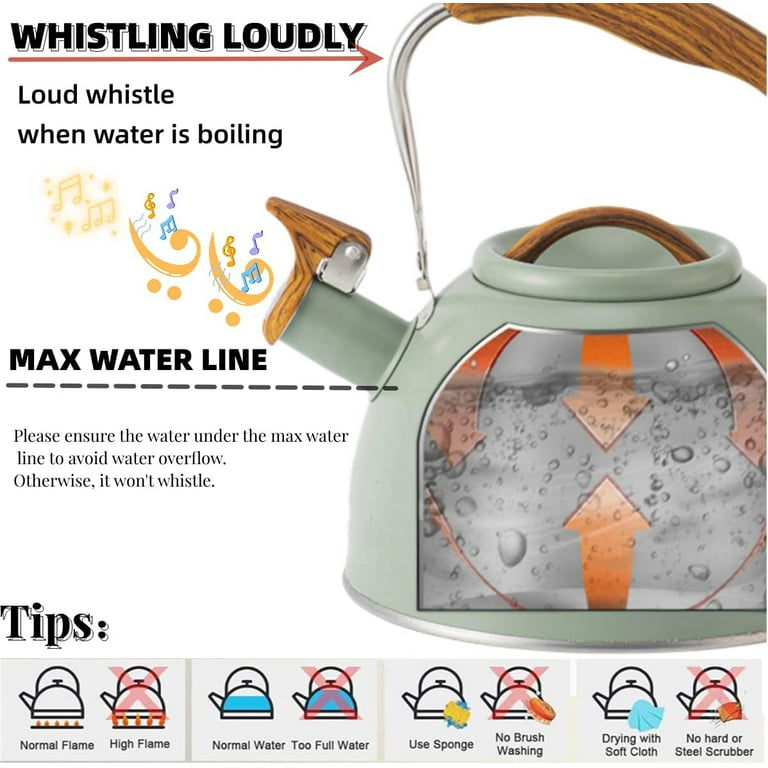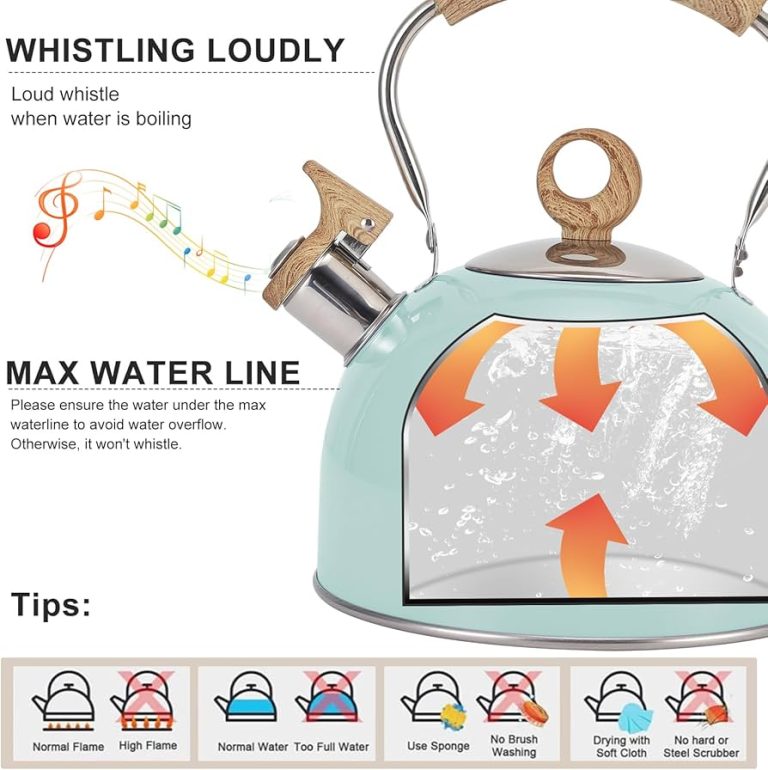Does the sound of your tea kettle whistling feel more like a fire alarm than a gentle reminder? You’re not alone.
Many tea lovers find themselves startled by the piercing sound that interrupts their peaceful morning ritual or afternoon break. But there’s good news—you don’t have to endure the ear-splitting noise any longer. Imagine enjoying a soothing cup of tea without the jarring interruption.
We’ll share simple tips and tricks to help you reduce the volume of your kettle’s whistle, making your tea time more relaxing and enjoyable. Keep reading to discover how you can reclaim the tranquility of your brew, without sacrificing the convenience of your trusty kettle.
Why Tea Kettles Whistle
Tea kettles whistle due to steam escaping through a small opening. Reduce noise by adjusting the lid securely. Choose a kettle with a quieter whistle for a more peaceful kitchen experience.
Have you ever wondered why tea kettles whistle? It’s a charming sound that signals your water is ready, but sometimes it can be too loud. This high-pitched noise is not just a random occurrence. It’s a fascinating interplay of physics and design, a feature that has become both iconic and, occasionally, a bit too noisy.Understanding The Science Behind The Whistle
The whistle of a tea kettle is a result of steam being forced through a small opening. As the water boils, it turns into steam, expanding and creating pressure. This pressure pushes the steam through the spout’s whistle, producing sound waves that we hear as a whistle.The Role Of The Kettle’s Design
The design of your kettle significantly influences the loudness of the whistle. Kettles with wider spouts generally produce a softer sound as steam escapes more freely. In contrast, kettles with narrow spouts focus the steam into a smaller area, amplifying the sound and creating that shrill whistle.Material Matters
The material of the kettle also affects the sound. Metal kettles often have a sharper and louder whistle compared to those made of glass or ceramic. Metal conducts heat more efficiently, which may cause a rapid build-up of steam pressure, resulting in a louder whistle.Manufacturers’ Intent
Why would manufacturers design kettles to whistle? The intent is practical: a whistle alerts you when the water is ready, preventing the kettle from boiling dry. However, not all whistles are created equal. Some are designed to be more pleasant or softer, catering to different preferences.Personal Experience And Adjustments
I remember the first time my kettle startled me with its piercing whistle. It was like an unexpected alarm clock. To soften the sound, I tried adjusting the kettle’s lid and spout position. It made a difference, proving that small tweaks can lead to a more peaceful kitchen experience. Is your kettle whistle too loud for your liking? Consider these factors and adjustments for a quieter brew. By understanding why kettles whistle, you can make informed choices to enjoy your tea time without the ear-piercing alarm.
Credit: www.walmart.com
Choosing The Right Kettle
Adjusting the kettle’s lid can reduce the noise. A loose lid allows steam to escape quietly. Positioning the kettle away from direct heat may also minimize the whistle’s volume.
Choosing the right kettle can significantly reduce that startling whistle that interrupts your peaceful morning routine. Many people underestimate the impact of the kettle’s design and material on the noise level. By selecting the right kettle, you can enjoy your tea-making process without the ear-piercing sound.Material Considerations
The material of your kettle plays a crucial role in the noise it produces. Stainless steel kettles are durable but often amplify the whistling sound. If you prefer a quieter option, consider a kettle made from glass or ceramic. These materials tend to absorb sound better, making the whistle less jarring. Copper kettles are another excellent choice. They conduct heat efficiently, which means your water boils faster and the whistle is shorter. This might surprise you, but the right material can transform your tea experience.Design Features
The design of your kettle can also affect the volume of its whistle. Look for kettles with a well-sealed lid and spout. A poorly sealed kettle allows steam to escape in various directions, increasing the noise level. On the other hand, a tightly sealed kettle directs steam efficiently, producing a less intense whistle. Some kettles come with adjustable whistles. These allow you to control the volume or even turn off the whistle completely. If you’ve ever wished you could enjoy your tea without an auditory alarm, this feature could be your new best friend. Have you considered the size of the kettle? Larger kettles often produce a louder whistle. A smaller kettle might be more suitable if you’re brewing just for yourself or a small family. It’s a simple change, but one that can make your mornings more serene. What kettle features are most important to you? Do you prioritize material, design, or perhaps both?Adjusting The Whistle
Calm the loud whistle of your tea kettle by adjusting the cap or reducing the heat. Consider using a softer gasket or repositioning the spout for a quieter brew. Enjoy peaceful tea time without the startling noise.
Adjusting the whistle on your tea kettle can be a game-changer, especially if you’re tired of that ear-piercing sound every time you boil water. Have you ever been jolted from a peaceful morning by a kettle’s shrill whistle? You’re not alone. Many people are unaware that it’s possible to customize this sound to a more pleasant level. Let’s explore how you can make your tea kettle whistle a little less jarring.Whistle Mechanism
Understanding how your kettle’s whistle works is the first step. Most tea kettles have a small device that creates sound as steam escapes through it. This is usually a metal or plastic whistle cap that sits on the spout. When steam pressure builds up, it forces the air through the whistle, creating that distinctive sound. Simple yet effective. However, if your whistle is too loud, it’s worth considering if this mechanism is functioning correctly. Is there any debris or mineral buildup affecting the sound? A quick clean might help.Customizing Sound Level
Have you ever thought about modifying your kettle to adjust its whistle volume? It’s simpler than you might think. Some kettles come with adjustable whistles, allowing you to change the sound by turning a small dial or adjusting a lever. If your kettle doesn’t have this feature, don’t worry. You can still experiment with DIY solutions. Try wrapping a thin layer of tape around the whistle hole. This can slightly dampen the sound without affecting functionality. Is your whistle still bothering you? Consider using a kettle with a different whistle design. Some models are specifically designed to produce a softer tone. Remember, the goal is to find a balance that alerts you without startling you. Making these adjustments can transform your tea-making routine. Imagine a gentle whistle signaling your water is ready, rather than a startling screech. Next time your kettle goes off, you might just find yourself smiling rather than cringing.
Credit: twistedsifter.com
Alternative Methods To Reduce Noise
Silence a tea kettle’s loud whistle by using silicone caps or adjusting the lid to reduce steam escape. Try using a lower heat to prevent water from boiling too vigorously. Opt for kettles with adjustable whistles or non-whistling designs for a quieter kitchen experience.
Are you tired of your tea kettle’s whistle echoing through your home like a blaring alarm? It’s a common issue that can be quite jarring, especially in the early morning or late at night. Luckily, there are practical methods to quieten that whistle without losing the convenience of knowing when your water is ready. Let’s dive into some alternative methods to reduce the noise.Using Heat Diffusers
A heat diffuser is a simple tool that can make a significant difference in the noise level of your tea kettle. By placing a heat diffuser between the burner and the kettle, you can distribute heat more evenly. This results in a quieter boil and a less piercing whistle. Heat diffusers are easy to find and use. They also have the added benefit of protecting your pots and pans from direct flame. So, not only will you enjoy a quieter kettle, but you’ll also extend the life of your cookware. Have you ever noticed how some kitchen gadgets are just lifesavers? A heat diffuser could be one of those for your daily tea ritual. Give it a try and see if it softens the whistle to a more pleasant sound.Reducing Heat Source
Another effective way to reduce the whistle’s volume is by lowering the heat source. Many times, kettles are placed on high heat to speed up the boiling process. But this can lead to an unnecessarily loud whistle. Try adjusting the burner to a medium or low setting once the water starts to heat. This will often result in a more gentle whistle. Why not experiment with how much heat is truly necessary to reach a boil? You might find that your kettle performs just as well on lower heat, without the ear-piercing noise. Simple adjustments to the heat source can lead to a more peaceful kitchen environment. Next time you put the kettle on, consider dialing down the heat and enjoy a quieter brewing experience.Maintaining Your Kettle
Quieting a loud tea kettle involves simple steps. Adjust the whistle or tighten the lid securely. Regular cleaning can also help. Keeping the kettle in top shape ensures a pleasant, noise-free tea time.
Maintaining Your Kettle A tea kettle that whistles too loudly can be quite a disturbance, turning a peaceful moment into an unwanted clamor. To keep your kettle in prime condition and minimize its noise, maintenance is key. Regular upkeep not only prevents excessive whistling but also extends the life of your kettle. Imagine the satisfaction of having a quiet, efficient kettle that works seamlessly every time you use it. Let’s delve into some practical steps for maintaining your kettle.Regular Cleaning
Cleaning your kettle regularly can significantly reduce the noise it makes. Mineral deposits can build up inside the kettle over time, affecting the whistle’s function. Have you noticed how some kettles get louder as they age? This is often due to these deposits. Use a mixture of equal parts water and vinegar to descale your kettle. Boil it, then let it sit for a few hours before rinsing thoroughly. This simple routine can prevent limescale from affecting the whistle’s clarity and volume.Checking For Damage
Inspect your kettle for any visible damage. A dent or crack can alter the way air moves through the spout, increasing the whistling sound. Have you ever examined the spout closely after a loud whistle? It might reveal a small flaw you hadn’t noticed before. Look for any loose parts, especially around the whistle mechanism. Tightening them can often solve noise issues. Don’t forget to check the lid, as an improper fit can also lead to louder whistling. Regular care and attention to these details not only keep your kettle functioning quietly but also ensure it lasts longer. Wouldn’t it be great to enjoy a peaceful tea time without the ear-piercing sound? Keep these tips in mind to maintain your kettle effectively.Exploring Silent Kettle Options
Tired of your tea kettle’s loud whistling disrupting your peace? You’re not alone. Many seek solutions to enjoy quiet tea-making moments. Silent kettle options can bring tranquility to your kitchen. Consider alternatives that hush the noise while still delivering hot water efficiently.
Electric Kettles
Electric kettles offer a quiet boiling experience. They heat water without the traditional whistle. These kettles come with automatic shut-off features. This ensures your water boils without any noise. Many models have adjustable temperature settings. You can choose the perfect temperature for your tea. Electric kettles are also energy-efficient. They boil water faster than traditional kettles.
Non-whistling Designs
Non-whistling designs focus on silent boiling. These kettles use innovative spout designs. The spout reduces noise during boiling. Some kettles have a lid that seals tightly. This prevents steam from escaping and creating noise. Non-whistling kettles often have insulated bodies. They keep the water hot longer without extra boiling.

Credit: www.amazon.com
Frequently Asked Questions
How To Make A Tea Kettle Not Whistle?
To stop a tea kettle from whistling, remove or block the whistle mechanism. You can also lower the heat slightly before boiling. Another option is choosing a kettle without a whistle feature. Regularly check and adjust the lid for a snug fit to avoid any sound.
How To Quieten A Noisy Kettle?
Descale the kettle regularly to reduce noise. Use a rubber mat underneath to absorb vibrations. Ensure the kettle is on a flat, stable surface. Check for loose parts and tighten them if necessary. Replace the kettle if it remains noisy after trying these solutions.
Why Is My Kettle Making A High Pitched Noise?
A high-pitched noise from your kettle often indicates limescale buildup or water overheating. Clean the kettle regularly to reduce limescale. Ensure the water level is correct and check for any damage to the heating element. These steps can help minimize noise and ensure efficient operation.
What Causes A Tea Kettle To Whistle?
A tea kettle whistles due to steam escaping through a small opening. The steam causes vibrations in the opening, producing sound. As water boils, pressure builds, forcing steam through the spout and creating the characteristic whistle. This alerts users that the water is ready for use.
Conclusion
Quieting a loud tea kettle is simpler than you think. Try adjusting the kettle’s lid to reduce noise. Consider using a heat diffuser for even heat distribution. A thicker kettle base can also help dampen sound. Regular maintenance is key.
Clean your kettle to prevent loud whistling. Experiment with different water levels to find the quietest boil. Choose kettles with softer whistles if buying new. Enjoy peaceful tea time without the noise. Small changes can make a big difference. Happy brewing!


